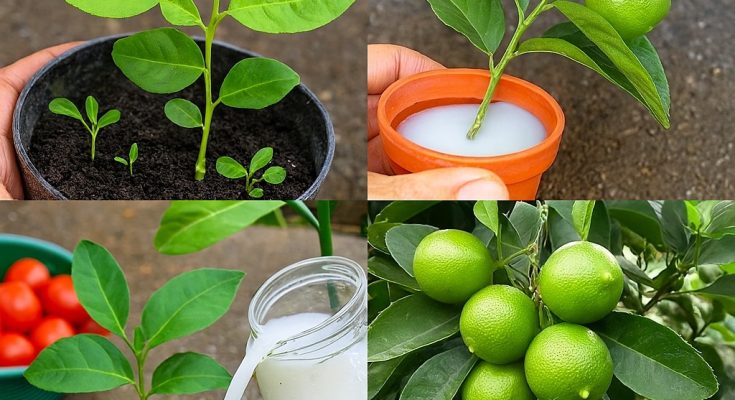If you have a lemon tree that is not producing fruit, whether it is planted in a pot, directly in the ground, or even in a plastic bottle, there is a simple yet effective technique that can significantly improve its growth and yield. This method provides essential nutrients to your lemon tree, ensuring a bountiful harvest of flowers and fruits.
Understanding Lemon Tree Requirements
Lemon trees require adequate sunlight for optimal growth and fruit production. Ideally, they should receive at least six hours of sunlight daily. Additionally, regular pruning encourages flowering and keeps the tree healthy. Strategic fertilization is also key to maximizing fruit yield.
Step-by-Step Fertilization Technique
1. Preparing the Soil
For lemon trees planted in the ground, create a circular trench around the base of the tree, approximately 20 cm away from the trunk and about 10 cm deep. If the tree is in a pot (e.g., a 20-liter container), create four small holes around the trunk, each about 10 cm deep. This ensures that nutrients are distributed evenly and do not cause root damage.
2. Applying Organic Matter
Use well-aged manure, preferably from cattle or poultry, or earthworm humus. This material enriches the soil with beneficial microorganisms and nutrients essential for tree growth. For trees in the ground, apply about 2 kg of aged manure. For potted trees, add two tablespoons of manure into each hole.
3. Adding Wood Ash for Nutrients
Wood ash is an excellent natural fertilizer rich in phosphorus, potassium, and other trace minerals. It enhances fruit flavor, making them sweeter and juicier. Add about half a tablespoon of wood ash to each hole or trench around the tree.
4. Incorporating Urea for Growth Support
Urea is a nitrogen-rich fertilizer that promotes vigorous growth and helps with fruit formation. Apply a small amount—about 6 grams per hole—ensuring even distribution. This step provides essential energy for the tree to develop strong branches, healthy leaves, and abundant fruit.
5. Covering and Watering
Once all the fertilizers are applied, cover the holes with soil to prevent nutrient loss. Immediately after covering, water the area thoroughly. This helps dissolve the nutrients and allows them to penetrate the soil effectively, reaching the roots of the tree.
Alternative Method for Plastic Bottle Cultivation
For those growing lemon trees in plastic bottles, follow these adjusted steps:
-
- Create a small, shallow hole on the side of the bottle.
- Apply the fertilizers in a different order: first urea, then manure, and finally wood ash.
- Cover the hole with a thin layer of soil and water immediately.
- Choose an area with minimal roots to avoid root damage from the fertilizer.
Maintaining Optimal Fertilization
Repeat this fertilization process every 3-4 months. This ensures the tree continues receiving essential nutrients for ongoing fruit production. Since urea is a strong fertilizer, avoid applying it too close to the trunk to prevent root burn.
Observing Results
Proper fertilization significantly boosts flower production, resulting in a tree covered with blossoms and developing fruit. Within a short period, the tree should show visible improvements, with vibrant green leaves and increased flowering. If done consistently, this method encourages fruit production throughout the year, especially for lemon varieties like the Tahiti lemon.
Conclusion
Growing a thriving lemon tree, even in limited spaces, is achievable with proper care and fertilization. By following this simple yet effective technique, you can ensure your tree remains healthy and produces an abundance of fruits year-round. Whether growing in the ground, in pots, or using unconventional methods like plastic bottles, providing essential nutrients through natural fertilization will help your lemon tree flourish.
